Forest Type Classification Based on Integrated Spectral-Spatial-Temporal Features and Random Forest Algorithm—A Case Study in the Qinling Mountains
Abstract
:1. Introduction
2. Materials and Methods
2.1. Study Area
2.2. Dataset
2.2.1. Sentinel-2 Remote Sensing Images
2.2.2. Ancillary Datasets
2.2.3. Training and Validation Data
2.4. Methodology
2.4.1. Preprocessing
2.4.2. Feature Derivation
Spectral Features
Spatial Features
Temporal Features
2.4.3. Random Forest Algorithm and Feature Selection
2.4.4. Evaluation and Feature Importance Assessment
Evaluation
Feature Importance Assessment
3. Results
3.1. SST Feature Set and Classification Result
3.2. Feature Importance for Different Forest Type Classification
3.3. Evaluation of SST-Based RF Classifier and Classification Result
4. Discussion
4.1. Spectral, Spatial, and Temporal Features
4.2. Feature Importance
4.3. Comparison with Existing Products
4.4. Forest Type Distribution in QML
5. Conclusions
Author Contributions
Funding
Conflicts of Interest
References
- Masek, J.G.; Hayes, D.J.; Hughes, M.J.; Healey, S.P.; Turner, D.P. The role of remote sensing in process-scaling studies of managed forest ecosystems. For. Ecol. Manag. 2015, 355, 109–123. [Google Scholar] [CrossRef] [Green Version]
- McKinley, D.C.; Ryan, M.G.; Birdsey, R.A.; Giardina, C.P.; Harmon, M.E.; Heath, L.S.; Houghton, R.A.; Jackson, R.B.; Morrison, J.F.; Murray, B.C. A synthesis of current knowledge on forests and carbon storage in the United States. Ecol. Appl. 2011, 21, 1902–1924. [Google Scholar] [CrossRef] [PubMed] [Green Version]
- Townshend, J.; Masek, J.G.; Huang, C.Q.; Vermote, E.F.; Gao, F.; Channan, S.; Sexton, J.O.; Feng, M.; Narasimhan, R.; Kim, D.; et al. Global characterization and monitoring of forest cover using Landsat data: Opportunities and challenges. Int. J. Digit. Earth 2012, 5, 373–397. [Google Scholar] [CrossRef]
- UNSC. Revised List of Global Sustainable Development Goal Indicators, United Nations Statistical Commission. Available online: https://unstats.un.org/sdgs (accessed on 6 July 2017).
- Fassnacht, F.E.; Latifi, H.; Stereńczak, K.; Modzeleska, A.; Lefsky, M.; Waser, L.T.; Straub, C.; Ghosh, A. Review of studies on tree species classification from remotely sensed data. Remote Sens. Environ. 2016, 186, 64–87. [Google Scholar] [CrossRef]
- Yan, L.; Jiang, W. Progress in the study of vegetation cover classification of multispectral remote sensing imagery. Remote Sens. Land Resour. 2016, 28, 8–13. [Google Scholar]
- Zhang, S.F.; Xing, Y.Q.; Abuduaini, A.; Sun, X. Comparison on Forest Type Classification Methods Based on TM Images. Forest Eng. 2014, 30, 18–21. [Google Scholar]
- Zhang, X.; Zhang, Y.; Liu, L.; Zhang, J.; Gao, J. Remote sensing monitoring of the subalpine coniferous forests and quantitative analysis of the characteristics of succession in east mountain area of Tibetan Plateau—A case study with Zamtange county. Agric. Sci. Technol. 2011, 12, 926–930. [Google Scholar]
- Sayn-Wittgenstein, L. Recognition of tree species on aerial photographs. In Information Report FMR-X-118; Forest Management Institute: Ottawa, ON, Canada, 1978. [Google Scholar]
- Franklin, S.E.; Hall, R.J.; Moskal, L.M.; Maudie, A.J.; Lavigne, M.B. Incorporating texture into classification of forest species composition from airborne multispectral images. Int. J. Remote Sens. 2000, 21, 61–79. [Google Scholar] [CrossRef]
- Mallinis, G.; Koutsias, N.; Tsakiri-Strati, M.; Karteris, M. Object-based classification using Quickbird imagery for delineating forest vegetation polygons in a Mediterranean test site. ISPRS J. Photogramm. Remote Sens. 2008, 63, 237–250. [Google Scholar] [CrossRef]
- Johansen, K.; Phinn, S. Mapping structural parameters and species composition of riparian vegetation using IKONOS and Landsat ETM+ data in Australian tropical savannahs. Photogramm. Eng. Remote Sens. 2006, 72, 71–80. [Google Scholar] [CrossRef]
- Gärtner, P.; Förster, M.; Kleinschmit, B. The benefit of synthetically generated RapidEye and Landsat 8 data fusion time series for riparian forest disturbance monitoring. Remote Sens. Environ. 2016, 177, 237–247. [Google Scholar] [CrossRef] [Green Version]
- Liu, Y.; Gong, W.; Hu, X.; Gong, J. Forest Type Identification with Random Forest Using Sentinel-1A, Sentinel-2A, Multi-Temporal Landsat-8 and DEM Data. Remote Sens. 2018, 10, 946. [Google Scholar] [CrossRef]
- Xia, Q.; Qin, C.Z.; Li, H.; Huang, C.; Su, F.Z. Mapping Mangrove Forests Based on Multi-Tidal High-Resolution Satellite Imagery. Remote Sens. 2018, 10, 1343. [Google Scholar] [CrossRef]
- Gao, X.; Bai, H.Y.; Zhang, S.H.; He, Y.N. Climatic change tendency in Qinling Mountains from 1959 to 2009. Bull. Soil Water Conserv. 2012, 32, 207–211. [Google Scholar]
- Hird, J.N.; DeLancey, E.R.; McDermid, G.J.; Kariyeva, J. Google Earth Engine, Open-Access Satellite Data, and Machine Learning in Support of Large-Area Probabilistic Wetland Mapping. Remote Sens. 2017, 9, 1315. [Google Scholar] [CrossRef]
- Kaspar, H.; Andreas, H.; Lukas, W. Technical Report; Centre for Development and Environment (CDE) University of Bern: Bern, Switzerland, 2017. [Google Scholar]
- Xia, H.; Li, A.; Zhao, W.; Bian, J.; Lei, G. Spatiotemporal variations of forest phenology in the Qinling zone based on remote sensing monitoring, 2001–2010. Prog. Geog. 2015, 34, 1297–1305. [Google Scholar]
- Korhonen, L.; Hadi; Packalen, P.; Rautiainen, M. Comparison of Sentinel-2 and Landsat 8 in the estimation of boreal forest canopy cover and leaf area index. Remote Sens. Environ. 2017, 195, 259–274. [Google Scholar] [CrossRef]
- Wicaksono, P.; Danoedoro, P.; Hartono; Nehren, U. Mangrove biomass carbon stock mapping of the Karimunjawa islands using multispectral remote sensing. Int. J. Remote Sens. 2016, 37, 26–52. [Google Scholar] [CrossRef]
- Gitelson, A.A.; Gritz, Y.; Merzlyak, M.N. Relationships between leaf chlorophyll content and spectral reflectance and algorithms for non-destructive chlorophyll assessment in higher plant leaves. J. Plant Physiol. 2003, 160, 271–282. [Google Scholar] [CrossRef]
- Wolter, P.T.; Mladenoff, D.J.; Host, G.E.; Crow, T.R. Improved forest classification in the northern lake-states using multitemporal Landsat imagery. Photogramm. Eng. Remote Sens. 1995, 61, 1129–1143. [Google Scholar]
- Maiersperger, T.K.; Cohen, W.B.; Ganio, L.M. A TM-based hardwood-conifer mixture index for closed canopy forests in the Oregon Coast Range. Int. J. Remote Sens. 2001, 22, 1053–1066. [Google Scholar] [CrossRef]
- Dymond, C.C.; Mladenoff, D.J.; Radeloff, V.C. Phenological differences in tasseled cap indices improve deciduous forest classification. Remote Sens. Environ. 2002, 80, 460–472. [Google Scholar] [CrossRef]
- Wang, D.; Wan, B.; Qiu, P.; Su, Y.; Guo, Q.; Wang, R.; Sun, F.; Wu, X. Evaluating the Performance of Sentinel-2, Landsat 8 and Pléiades-1 in Mapping Mangrove Extent and Species. Remote Sens. 2018, 10, 1468. [Google Scholar] [CrossRef]
- Huang, X.; Liu, X.; Zhang, L. A multichannel gray level co-occurrence matrix for multi/hyperspectral image texture representation. Remote Sens. 2014, 6, 8424–8445. [Google Scholar] [CrossRef]
- Ouma, Y.O.; Tetuko, J.; Tateishi, R. Analysis of co-occurrence and discrete wavelet transform textures for differentiation of forest and non-forest vegetation in very-high-resolution optical-sensor imagery. Int. J. Remote Sens. 2008, 29, 3417–3456. [Google Scholar] [CrossRef]
- Wang, T.; Zhang, H.; Lin, H.; Fang, C. Textural–spectral feature-based species classification of mangroves in Mai Po nature reserve from Worldview-3 imagery. Remote Sens. 2016, 8, 24. [Google Scholar] [CrossRef]
- Yan, E.; Wang, G.; Lin, H.; Xia, C.; Sun, H. Phenology-based classification of vegetation cover types in Northeast China using MODIS NDVI and EVI time series. Int. J. Remote Sens. 2015, 36, 489–512. [Google Scholar] [CrossRef]
- Jakubauskas, M.E.; Legates, D.R.; Kastens, J.H. Crop Identification Using Harmonic Analysis of Time-Series AVHRR NDVI Data. Comput. Electron. Agric. 2002, 37, 127–139. [Google Scholar] [CrossRef]
- Zhang, X.; Friedl, M.A.; Schaaf, C.B.; Strahler, A.H.; Hodges, J.C.F.; Gao, F.; Reedb, B.C.; Huetec, A. Monitoring Vegetation Phenology Using MODIS. Remote Sens. Environ. 2003, 84, 471–475. [Google Scholar] [CrossRef]
- Gorelick, N.; Hancher, M.; Dixon, M.; Ilyushchenko, S.; Thau, D.; Moore, R. Google Earth Engine: Planetary-scale geospatial analysis for everyone. Remote Sens. Environ. 2017, 202, 18–27. [Google Scholar] [CrossRef]
- Breiman, L. Random forests. Mach. Learn. 2001, 45, 5–32. [Google Scholar] [CrossRef]
- Belgiu, M.; Drăguţ, L. Random forest in remote sensing: A review of applications and future directions. ISPRS J. Photogramm. Remote Sens. 2016, 114, 24–31. [Google Scholar] [CrossRef]
- Gómez, C.; White, J.C.; Wulder, M.A. Optical remotely sensed time series data for land cover classification: A review. ISPRS J. Photogramm. Remote Sens. 2016, 116, 55–72. [Google Scholar] [CrossRef] [Green Version]
- Pham, L.T.H.; Brabyn, L. Monitoring mangrove biomass change in Vietnam using spot images and an object-based approach combined with machine learning algorithms. ISPRS J. Photogramm. Remote Sens. 2017, 128, 86–97. [Google Scholar] [CrossRef]
- Gregorutti, B.; Michel, B.; Saint-Pierre, P. Correlation and variable importance in random forests. Stat. Comput. 2017, 27, 659–678. [Google Scholar] [CrossRef]
- Luo, C.Q.; Lin, H.; Sun, H.; Wu, Z.S. Based on MODIS image large-scale forest resources information extraction method. J. Central South. Univ. For. Tech. 2015, 11, 21–26. [Google Scholar]
- Pasquarella, V.J.; Holden, C.E.; Woodcock, C.E. Improved mapping of forest type using spectral-temporal Landsat features. Remote Sens. Environ. 2018, 210, 193–207. [Google Scholar] [CrossRef]
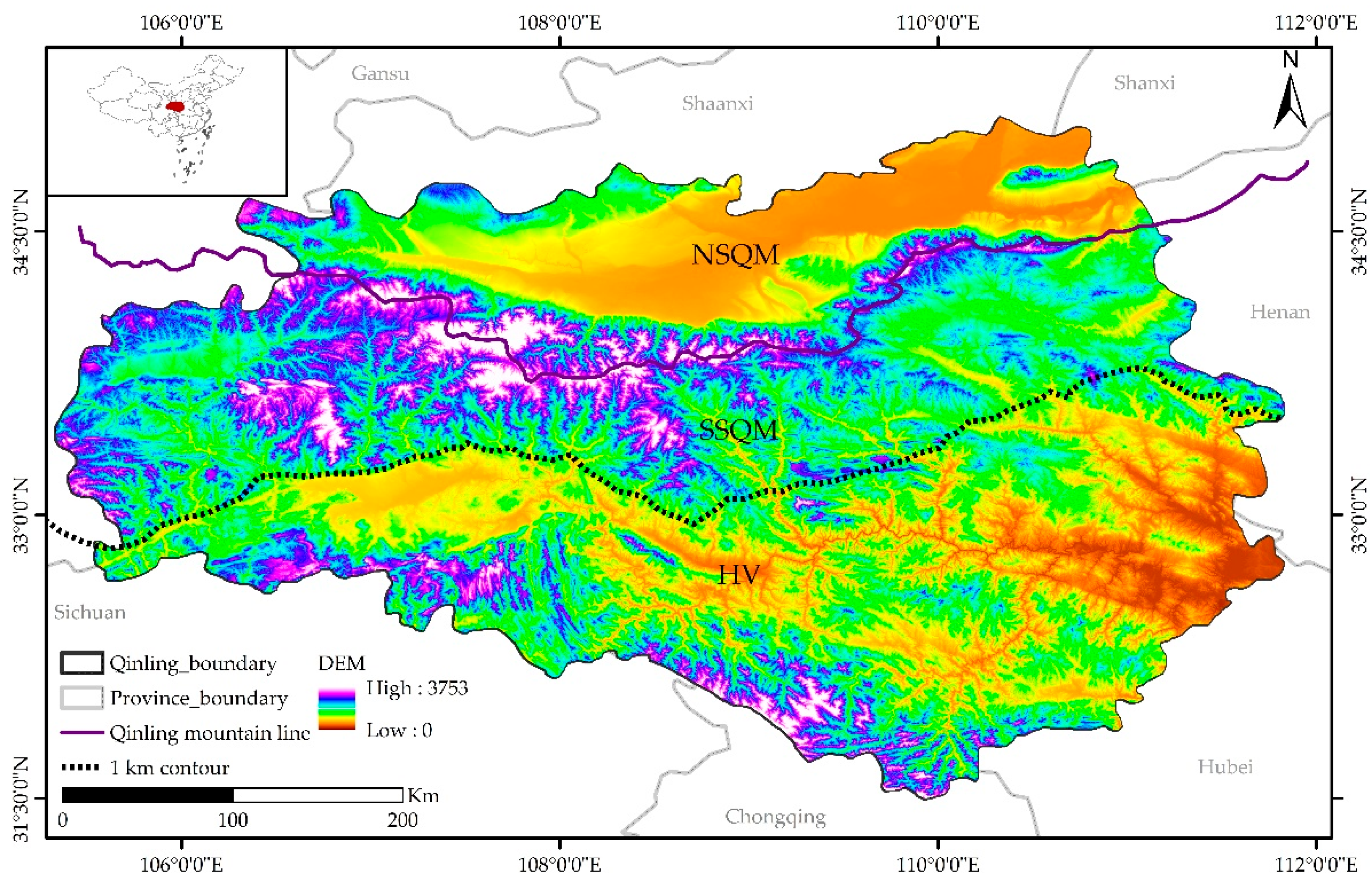
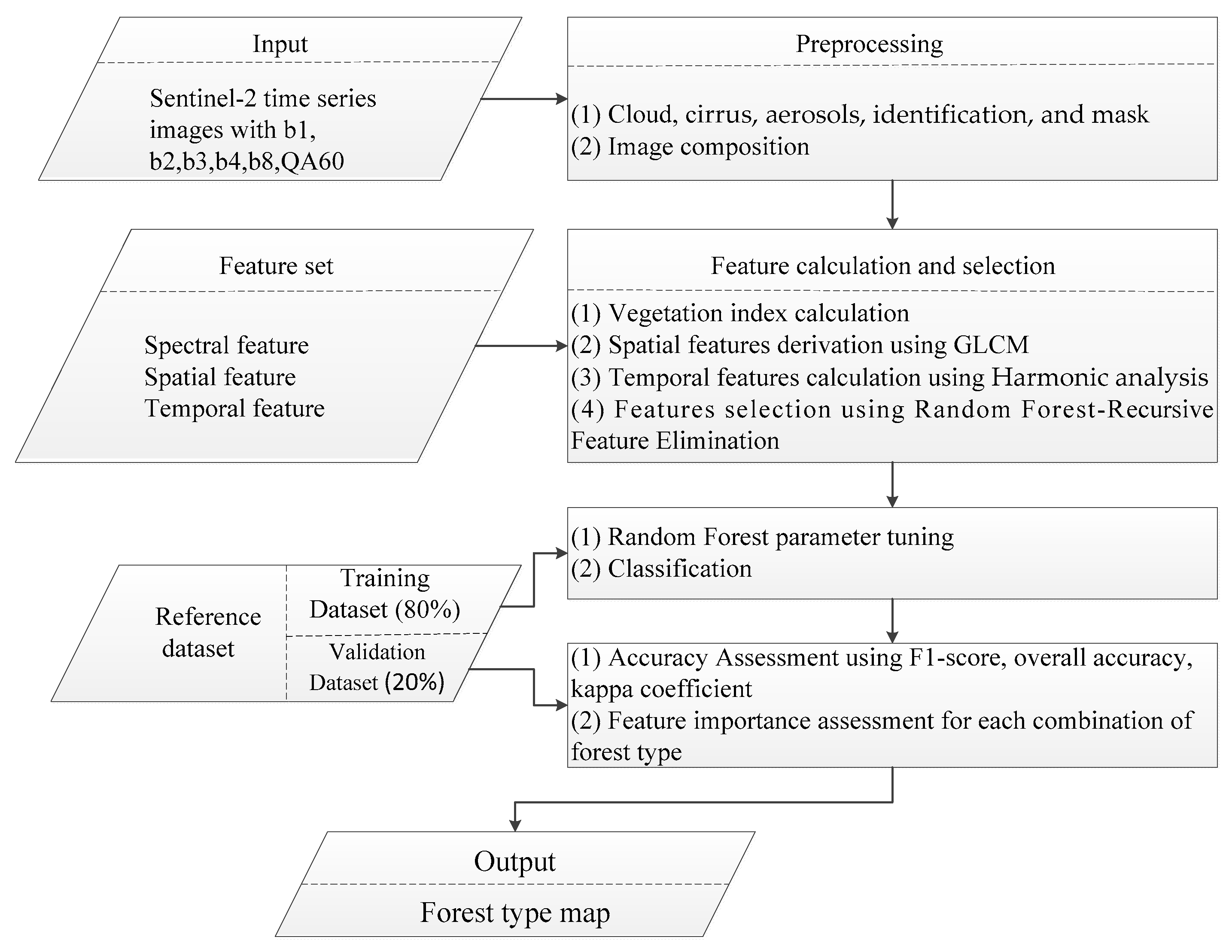
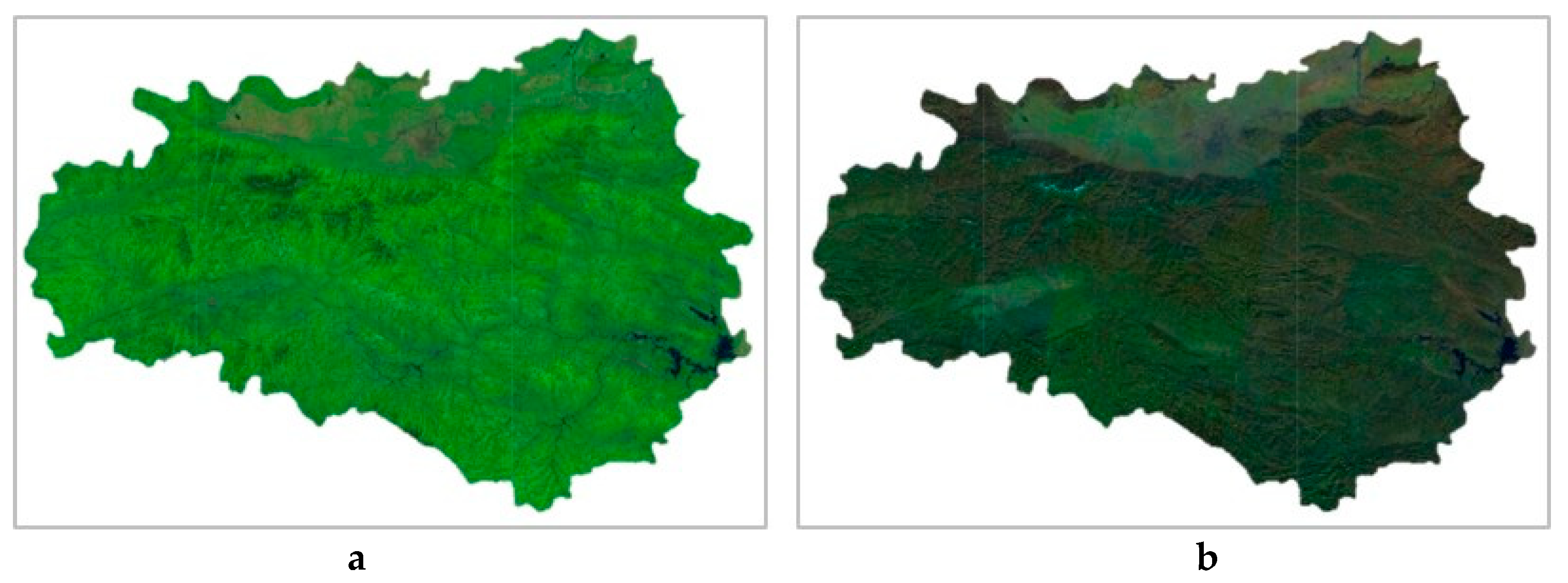
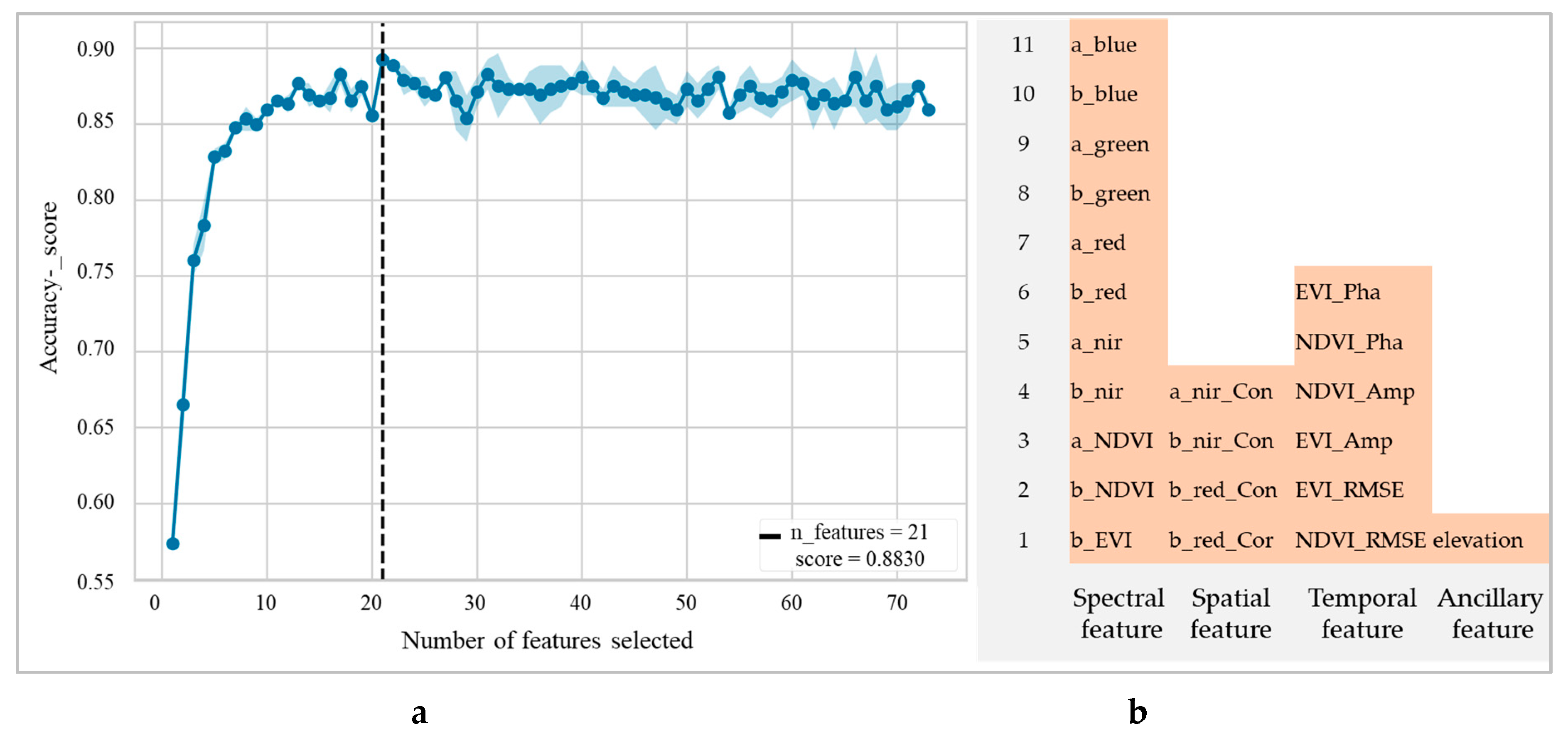
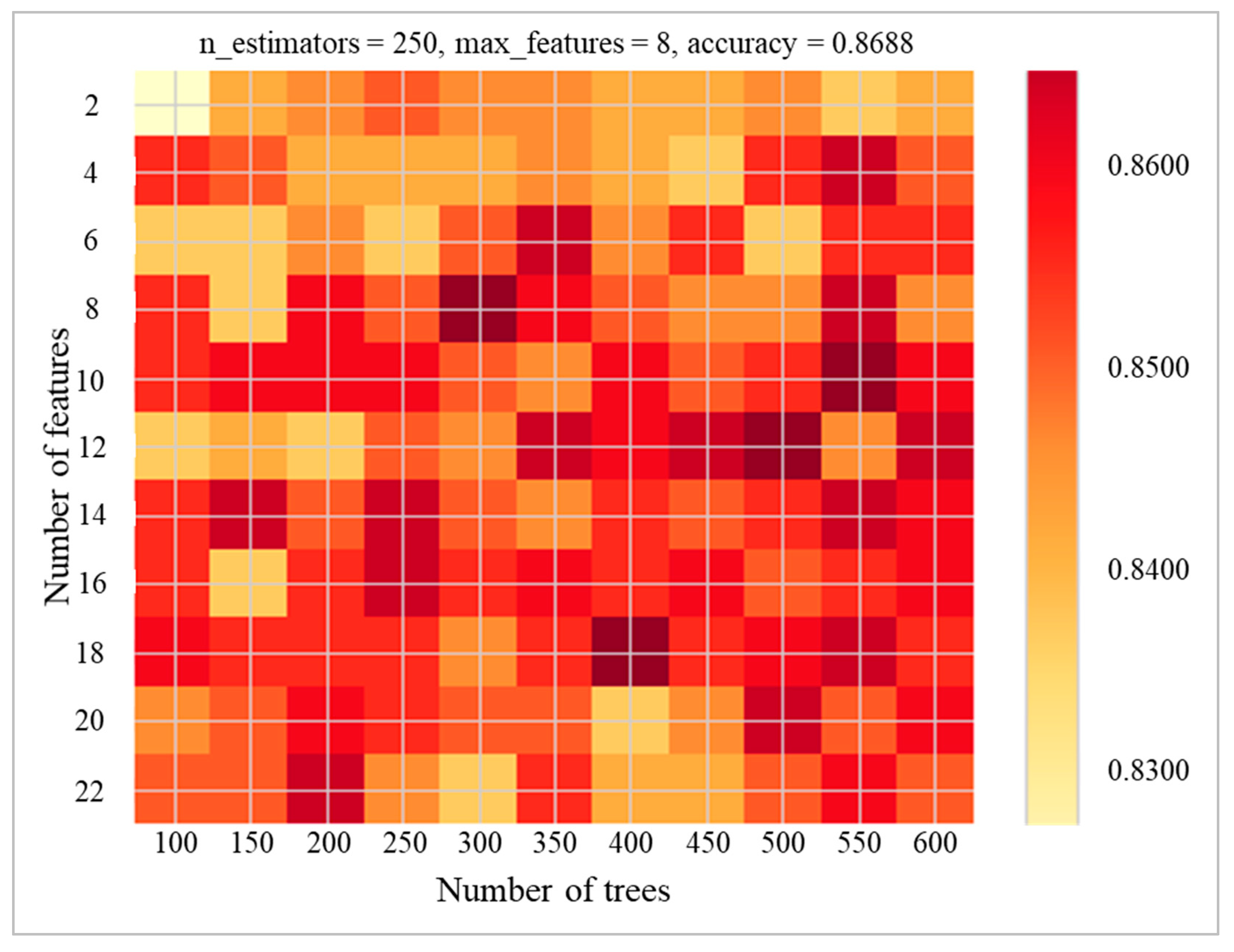

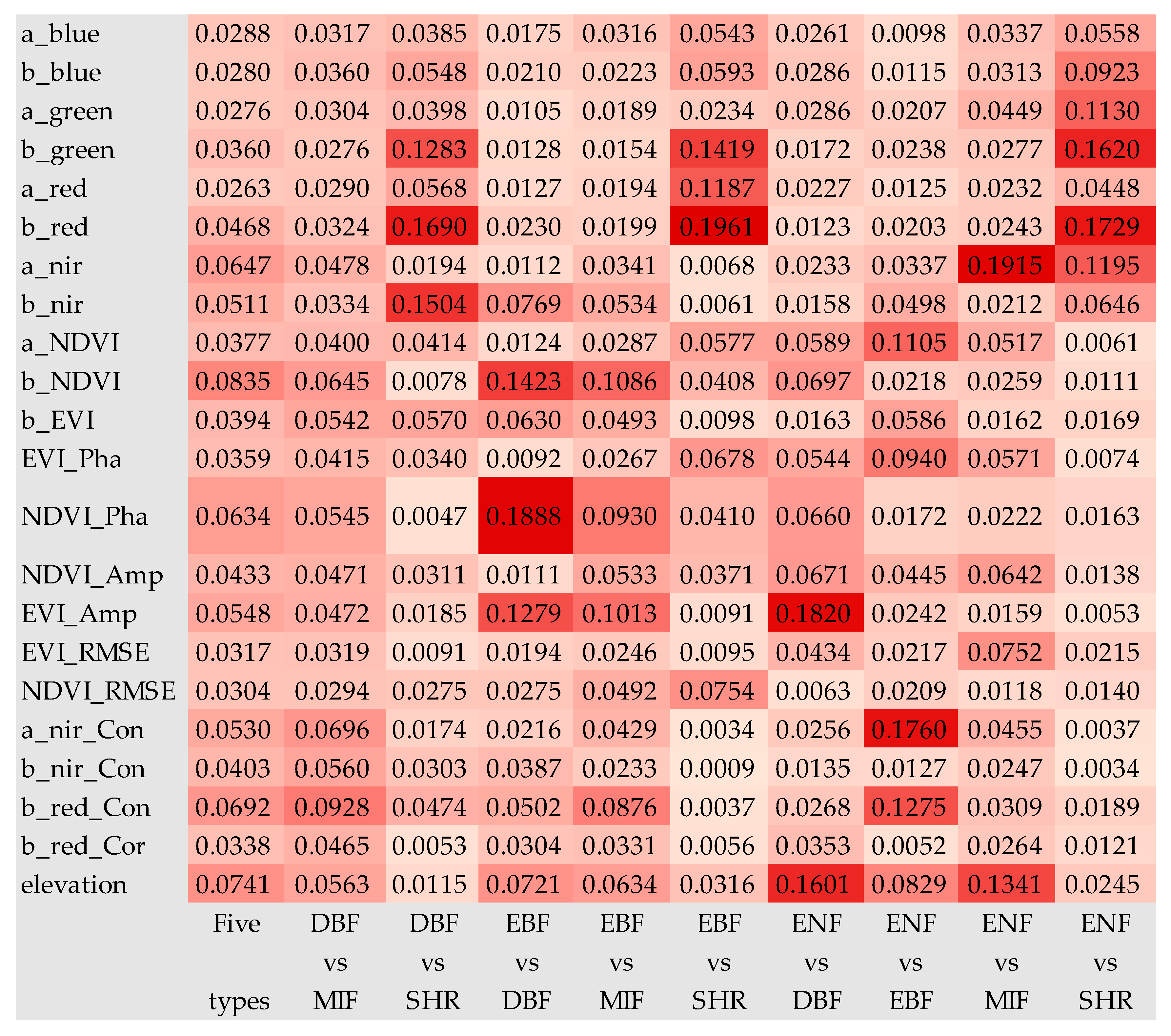
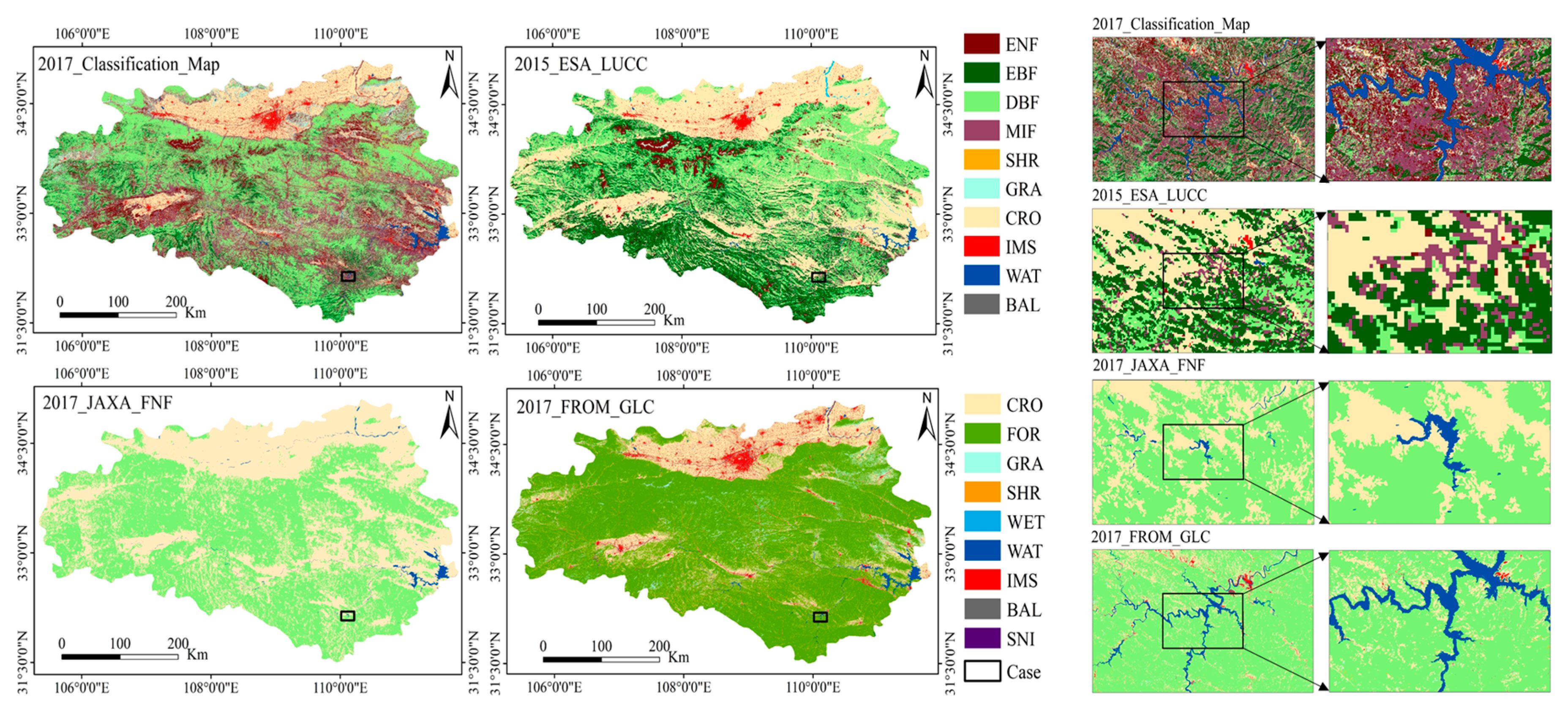
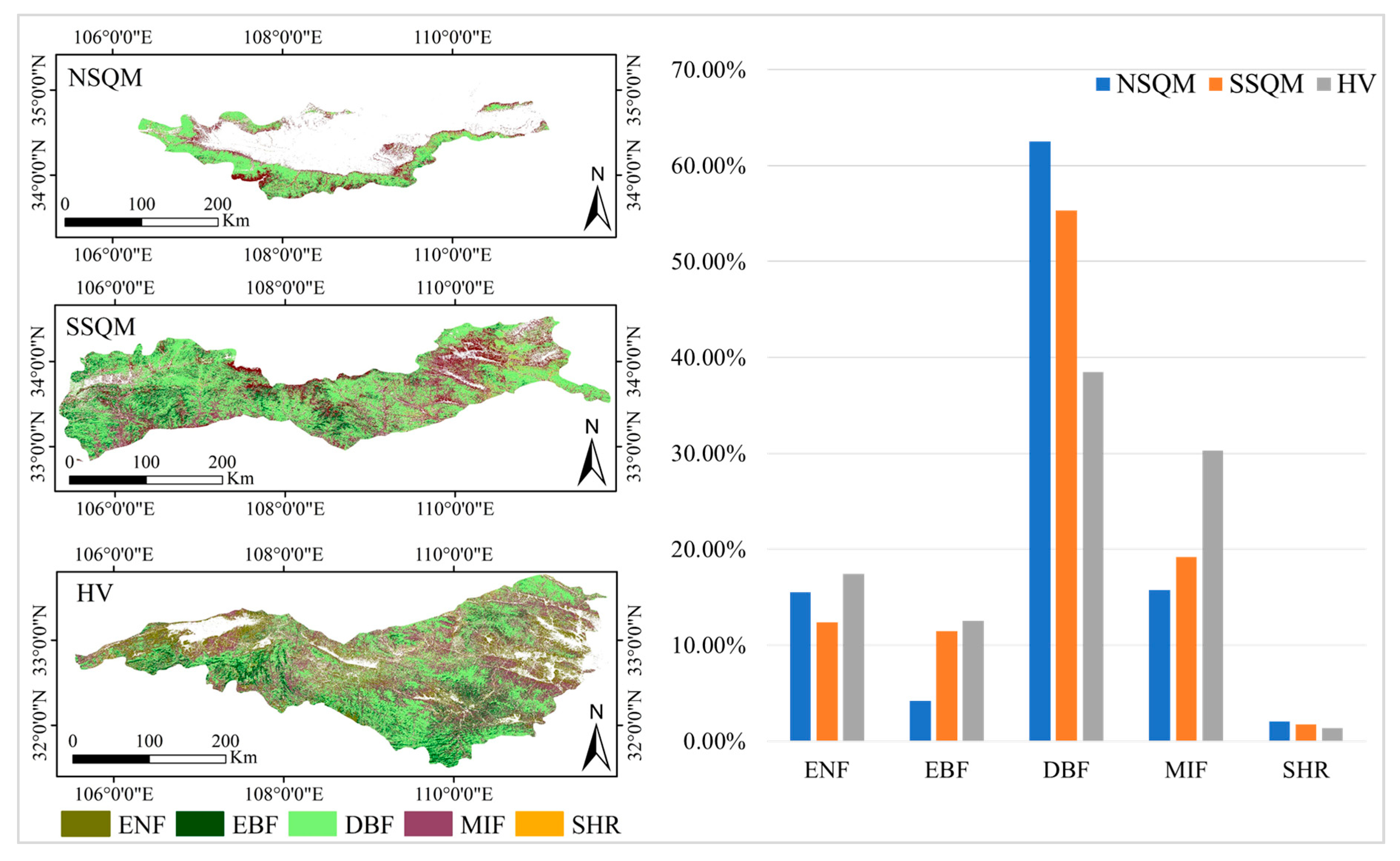
| Land Cover Type | Abbreviation | Training Points | Validation Points |
|---|---|---|---|
| Evergreen needleleaf forest | ENF | 124 | 31 |
| Evergreen broadleaf forest | EBF | 128 | 32 |
| Deciduous broadleaf forest | DBF | 184 | 46 |
| Mixed forest | MIF | 104 | 26 |
| Shrub | SHR | 40 | 10 |
| Grassland | GRD | 68 | 17 |
| Cropland | CRD | 104 | 26 |
| Water | WAR | 52 | 13 |
| Built area | BUA | 16 | 4 |
| Bare land | BAL | 64 | 16 |
| Type | Index | Reference |
|---|---|---|
| Spectral feature | blue, green, red, nir, NDVI, EVI, NDWI, MSAVI | [20,21,22,23,24,25] |
| Spatial feature | blue_contrast, green_contrast, red_contrast, nir_contrast | [26,27,28,29,30,31] |
| blue_entropy, green_entropy, red_entropy, nir_entropy | ||
| blue_correlation, gren_correlation, red_correlation, nir_correlation | ||
| Temporal feature | blue_amplitude, green_amplitude, red_amplitude, nir_amplitude, NDVI_amplitude, EVI_amplitude | [32,33,34] |
| blue_phase, green_phase, red_phase, nir_phase, NDVI_phase, EVI_phase | ||
| blue_RMSE, green_RMSE, red_RMSE, nir_RMSE, NDVI_RMSE, EVI_phase | ||
| Ancillary feature | Elevation, aspect, slope | [15,23] |
| Land Cover Type | Precision | Recall | F1 Score |
|---|---|---|---|
| ENF | 0.90 | 0.90 | 0.90 |
| EBF | 0.93 | 0.84 | 0.89 |
| DBF | 0.83 | 0.87 | 0.85 |
| MIF | 0.83 | 0.92 | 0.87 |
| SHR | 0.89 | 0.80 | 0.84 |
| GRA | 0.81 | 1.00 | 0.89 |
| CRO | 0.88 | 0.88 | 0.88 |
| BUI | 0.91 | 0.77 | 0.83 |
| WAT | 0.80 | 1.00 | 0.89 |
| BAR | 0.92 | 0.69 | 0.79 |
| Average | 0.87 | 0.87 | 0.87 |
| Class | ENF | EBF | DBF | MIF | SHR | GRA | CRO | BUI | WAT | BAR |
|---|---|---|---|---|---|---|---|---|---|---|
| ENF | 28 | 2 | 0 | 1 | 0 | 0 | 0 | 0 | 0 | 0 |
| EBF | 1 | 27 | 4 | 0 | 0 | 0 | 0 | 0 | 0 | 0 |
| DBF | 2 | 0 | 40 | 4 | 0 | 0 | 0 | 0 | 0 | 0 |
| MIF | 0 | 0 | 2 | 24 | 0 | 0 | 0 | 0 | 0 | 0 |
| SHR | 0 | 0 | 2 | 0 | 8 | 0 | 0 | 0 | 0 | 0 |
| GRA | 0 | 0 | 0 | 0 | 0 | 17 | 0 | 0 | 0 | 0 |
| CRO | 0 | 0 | 0 | 0 | 0 | 2 | 23 | 1 | 0 | 0 |
| BUI | 0 | 0 | 0 | 0 | 0 | 0 | 1 | 10 | 1 | 1 |
| WAT | 0 | 0 | 0 | 0 | 0 | 0 | 0 | 0 | 4 | 0 |
| BAR | 0 | 0 | 0 | 0 | 1 | 2 | 2 | 0 | 0 | 11 |
| UA | 90.32% | 84.38% | 86.96% | 92.31% | 80.00% | 100.00% | 88.46% | 76.92% | 100.00% | 68.75% |
| PA | 90.32% | 93.10% | 83.33% | 82.76% | 88.89% | 80.95% | 88.46% | 90.91% | 80.00% | 91.67% |
| OA | 86.88% | |||||||||
| KC | 0.85 | |||||||||
© 2019 by the authors. Licensee MDPI, Basel, Switzerland. This article is an open access article distributed under the terms and conditions of the Creative Commons Attribution (CC BY) license (http://creativecommons.org/licenses/by/4.0/).
Share and Cite
Cheng, K.; Wang, J. Forest Type Classification Based on Integrated Spectral-Spatial-Temporal Features and Random Forest Algorithm—A Case Study in the Qinling Mountains. Forests 2019, 10, 559. https://doi.org/10.3390/f10070559
Cheng K, Wang J. Forest Type Classification Based on Integrated Spectral-Spatial-Temporal Features and Random Forest Algorithm—A Case Study in the Qinling Mountains. Forests. 2019; 10(7):559. https://doi.org/10.3390/f10070559
Chicago/Turabian StyleCheng, Kai, and Juanle Wang. 2019. "Forest Type Classification Based on Integrated Spectral-Spatial-Temporal Features and Random Forest Algorithm—A Case Study in the Qinling Mountains" Forests 10, no. 7: 559. https://doi.org/10.3390/f10070559
APA StyleCheng, K., & Wang, J. (2019). Forest Type Classification Based on Integrated Spectral-Spatial-Temporal Features and Random Forest Algorithm—A Case Study in the Qinling Mountains. Forests, 10(7), 559. https://doi.org/10.3390/f10070559





